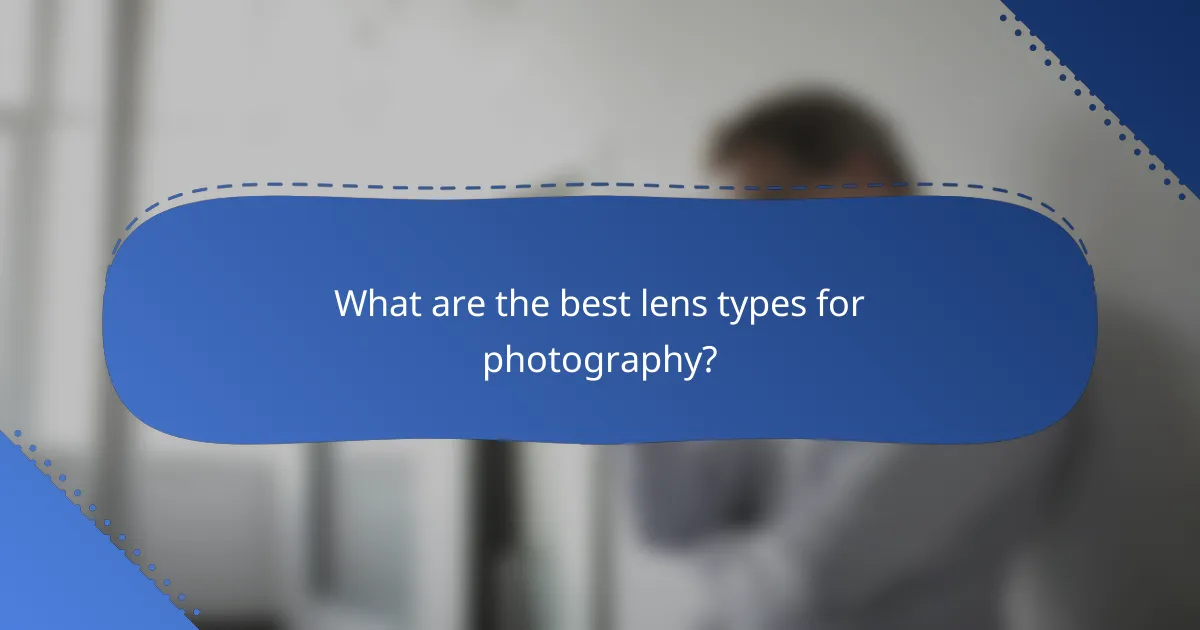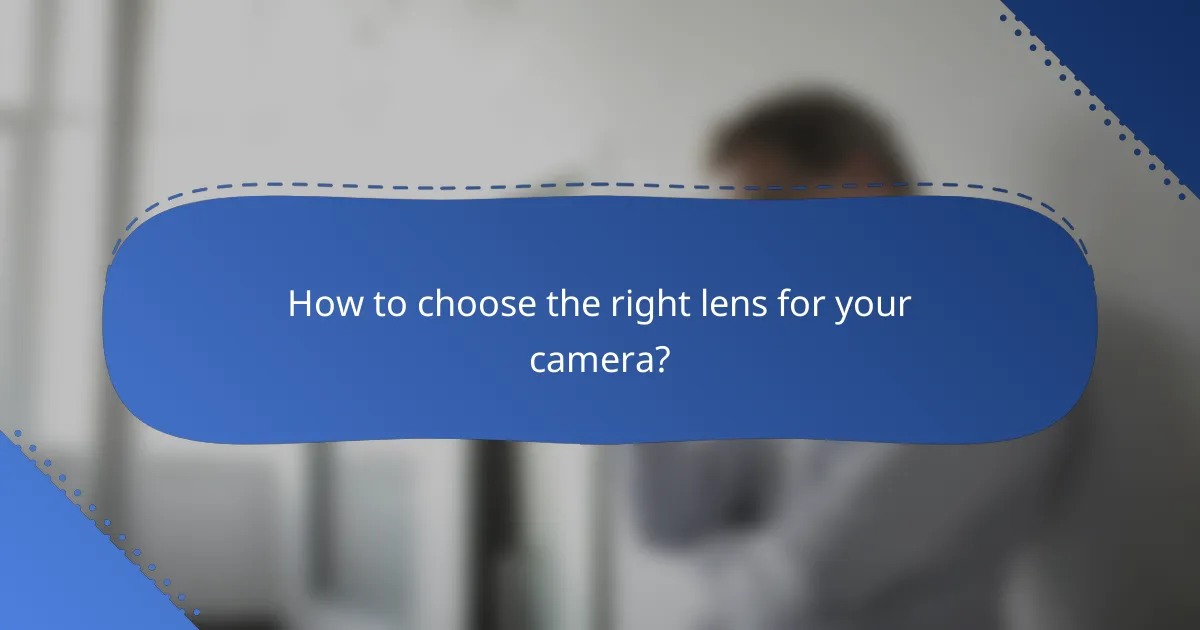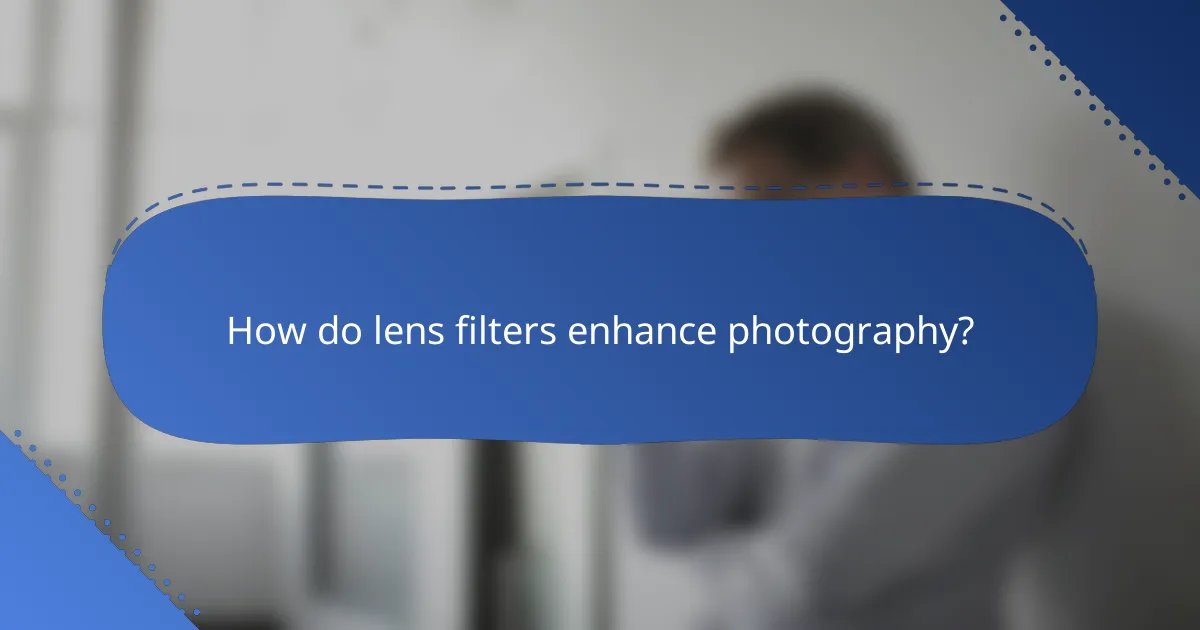In photography, selecting the right lens is crucial for achieving your desired outcome and adapting to various shooting conditions. With options like prime, zoom, macro, wide-angle, and telephoto lenses, each type offers unique advantages tailored to specific purposes. Understanding compatibility, focal length, and aperture size is essential for enhancing the quality and style of your images.

What are the best lens types for photography?
The best lens types for photography depend on the desired outcome and shooting conditions. Key options include prime, zoom, macro, wide-angle, and telephoto lenses, each serving specific purposes and offering unique advantages.
Prime lenses
Prime lenses have a fixed focal length, which typically results in sharper images and better low-light performance compared to zoom lenses. They are often lighter and more compact, making them ideal for street photography and portraiture.
Common focal lengths for prime lenses include 35mm, 50mm, and 85mm. When choosing a prime lens, consider the aperture size; lenses with larger apertures (like f/1.8 or f/1.4) allow for greater control over depth of field and low-light capabilities.
Zoom lenses
Zoom lenses offer variable focal lengths, allowing photographers to quickly adjust their framing without changing lenses. This versatility makes them suitable for various situations, from landscapes to wildlife photography.
Popular zoom ranges include 24-70mm and 70-200mm. While they provide convenience, zoom lenses may sacrifice some image quality and low-light performance compared to prime lenses, so consider your priorities when selecting one.
Macro lenses
Macro lenses are specifically designed for close-up photography, enabling detailed shots of small subjects like insects and flowers. They typically have a 1:1 magnification ratio, allowing you to capture intricate details.
When using a macro lens, pay attention to your lighting and stability, as shallow depth of field can make focusing challenging. A tripod and additional lighting may enhance your results, especially in low-light conditions.
Wide-angle lenses
Wide-angle lenses have shorter focal lengths, typically ranging from 14mm to 35mm, making them ideal for capturing expansive landscapes or tight interiors. They create a sense of depth and can exaggerate perspective, which can be creatively beneficial.
When using a wide-angle lens, be mindful of distortion, especially at the edges of the frame. This can be minimized by keeping the horizon level and avoiding extreme angles when composing your shot.
Telephoto lenses
Telephoto lenses have longer focal lengths, usually starting from 70mm and extending beyond 300mm, allowing you to capture distant subjects with clarity. They are commonly used in sports, wildlife, and portrait photography.
Consider the lens’s aperture size; larger apertures (like f/2.8) are beneficial for low-light conditions and achieving a shallow depth of field. Be aware that telephoto lenses can be heavy, so a sturdy tripod is often recommended for stability.

How to choose the right lens for your camera?
Choosing the right lens for your camera involves understanding compatibility, focal length, and aperture size. These factors significantly influence the quality and style of your photography.
Check camera mount compatibility
Camera mount compatibility is crucial when selecting a lens. Each camera brand typically has its own mount type, such as Canon’s EF or Nikon’s F mount. Ensure that the lens you choose is designed for your specific camera model to avoid any fitting issues.
Adapters are available for some mounts, but they can affect performance and functionality. It’s best to use lenses specifically designed for your camera to ensure optimal results.
Consider focal length requirements
Focal length determines how much of a scene you can capture and the level of detail in your images. Lenses typically range from wide-angle (around 10-35mm) to standard (35-70mm) and telephoto (70mm and above). Your choice should reflect the type of photography you plan to do.
For landscape photography, a wide-angle lens is often preferred, while portraits may benefit from a standard or telephoto lens. Think about the subjects you’ll shoot most frequently to guide your decision.
Evaluate aperture size
Aperture size affects the amount of light entering the lens and influences depth of field. Lenses with larger maximum apertures (like f/1.4 or f/2.8) allow for better low-light performance and create a shallower depth of field, which is ideal for portraits.
Conversely, smaller apertures (like f/8 or f/11) are suitable for landscape photography, where more of the scene needs to be in focus. Consider your typical shooting conditions and desired effects when evaluating aperture options.

What lens styles are popular among photographers?
Popular lens styles among photographers include standard, specialty, and vintage lenses. Each style serves different creative needs and technical requirements, influencing the final image quality and aesthetic.
Standard lens styles
Standard lenses, often referred to as prime or normal lenses, typically have a focal length ranging from 35mm to 50mm. They provide a field of view that closely resembles human vision, making them versatile for various photography styles, including portraits and street photography.
When choosing a standard lens, consider the maximum aperture, as wider apertures (like f/1.8 or f/1.4) allow for better low-light performance and depth of field control. These lenses are generally lightweight and easy to carry, making them ideal for everyday use.
Specialty lens styles
Specialty lenses encompass a wide range of options, including macro, fisheye, and tilt-shift lenses. Macro lenses, with focal lengths typically between 60mm and 105mm, are designed for extreme close-up photography, capturing intricate details of small subjects.
Fisheye lenses offer a unique, distorted perspective with an ultra-wide field of view, while tilt-shift lenses allow for perspective correction and selective focus. Each specialty lens serves specific creative purposes, so selecting one depends on the desired effect and subject matter.
Vintage lens styles
Vintage lenses, often characterized by their unique optical qualities and build, can add a distinct charm to modern photography. These lenses, typically made before the digital era, may have unique bokeh and color rendition that many photographers seek for artistic projects.
When using vintage lenses, consider compatibility with modern camera bodies, often requiring adapters. Additionally, be mindful of potential optical imperfections, which can enhance or detract from the intended aesthetic, depending on your creative vision.

What factors affect lens compatibility?
Lens compatibility is influenced by several key factors, including the camera brand and model, mount type, and sensor size. Understanding these elements ensures that photographers select lenses that will function correctly with their camera systems.
Camera brand and model
The camera brand and model play a crucial role in lens compatibility. Different manufacturers, such as Canon, Nikon, and Sony, have unique lens mounts and electronic communication protocols. For instance, a Canon lens will not fit a Nikon camera due to differing mount designs.
Moreover, even within the same brand, compatibility can vary between models. For example, a lens designed for a full-frame Canon camera may not work on an APS-C model without potential cropping or functionality issues.
Mount type
Mount type refers to the physical connection between the lens and the camera body. Each camera brand typically has its own mount specifications, which dictate how lenses attach. Common mounts include Canon’s EF and RF, Nikon’s F and Z, and Sony’s E mount.
When purchasing a lens, ensure that it matches the mount type of your camera. Adapters are available for some combinations, but they may introduce limitations in autofocus or image quality.
Sensor size
Sensor size affects lens compatibility in terms of image coverage and performance. Full-frame lenses can be used on cameras with smaller sensors, but the reverse is not true. Using a smaller sensor lens on a full-frame camera may result in vignetting or a cropped image.
Additionally, lenses designed for smaller sensors often have a crop factor, which can impact the effective focal length. For example, a 50mm lens on an APS-C camera may behave like a 75mm lens due to the crop factor, affecting composition and depth of field.

How do lens filters enhance photography?
Lens filters enhance photography by modifying light before it reaches the camera sensor, allowing for improved image quality and creative effects. They can reduce glare, control exposure, and protect the lens, making them valuable tools for photographers.
Polarizing filters
Polarizing filters reduce reflections and glare from surfaces like water and glass, enhancing color saturation and contrast in outdoor photography. They work by filtering out certain light waves, which can result in clearer skies and more vivid foliage.
When using a polarizing filter, rotate it to find the optimal effect, typically at a 90-degree angle to the light source. Be mindful that these filters can reduce light entering the lens by about one to two stops, so adjust your exposure settings accordingly.
ND filters
Neutral Density (ND) filters reduce the amount of light entering the lens without affecting color balance, allowing for longer exposure times or wider apertures in bright conditions. This is particularly useful for achieving motion blur in waterfalls or creating a shallow depth of field in bright sunlight.
ND filters come in various strengths, typically measured in stops, ranging from 3 stops (ND8) to 10 stops (ND1000). Choose the strength based on your desired effect and lighting conditions, and remember to adjust your shutter speed or aperture to maintain proper exposure.
UV filters
UV filters were originally designed to block ultraviolet light, which can cause haziness in photos, especially at high altitudes or in bright sunlight. While modern digital sensors are less affected by UV light, these filters are still commonly used to protect the lens from scratches and dust.
When using UV filters, ensure they are of high optical quality to avoid degrading image sharpness. They should be considered as a protective measure rather than a necessity for image quality, especially in digital photography.
